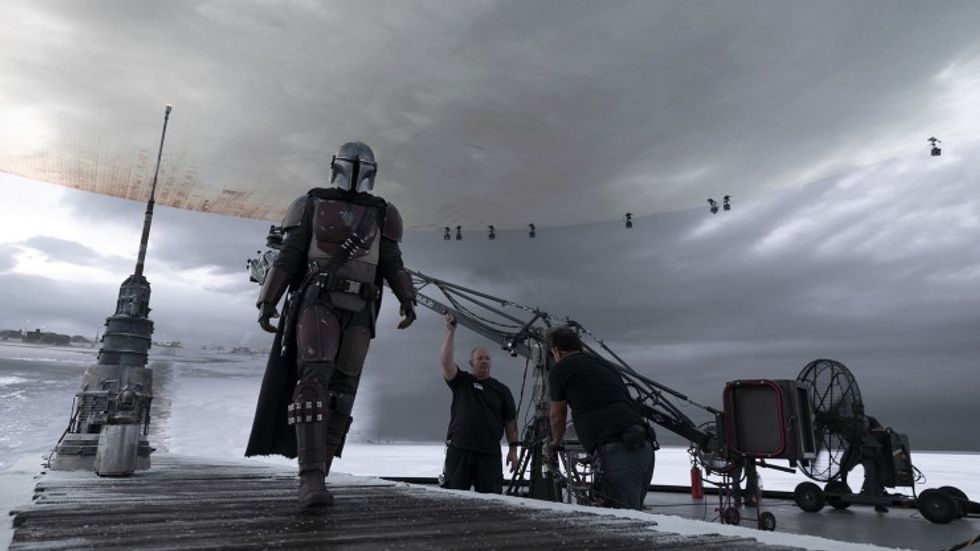Painting With Light—Understanding Pixel Mapping
These tube lights from Quasar Science give creatives new opportunities with Pixel Mapping. But what is it, and how do you implement it?

Quasar Science is a Los Angeles-based lighting company that has been making killer lights that are not only quality but simple enough to be implemented into any workflow.
From traditional filament-style LED bulbs to a wide array of dumb and smart tube lights, the company has done so well it was acquired by Videndum Production Solutions. Videndum also owns Anton Bauer and Litepanels to give you an idea of its pedigree.
With the versatile Rainbow Series of LED tube lights, Quasar Science allows filmmakers to use Pixel Mapping and get incredibly precise lighting that can help evaluate virtual productions and traditional green screens alike.
But what is Pixel Mapping, and how do you use it? First, we need to talk about one essential thing.
Image-Based Lighting
Matching traditional lighting to your scene can be tricky, especially when your scene is moving and you’re using outdoor lighting. The light rays bounce off everything around your scene and impart slight variations that can be impossible to generate with a single blub.
Coming from the VFX world, image-based lighting (or IBL) is a rendering technique that is created by capturing a representation of real-world light information as an image. This is typically done using a 360° camera but can also be taken from a standard 2D source.
The building blocks of an HDRI mapCredit: Association for Computing Machinery
In gaming and VFX, this information can then be projected onto a dome or sphere to create an environment map that can light your scene.
Put simply, you take an HDR picture and use those values to create a light map that will impart realistic lighting onto your scene.
But that’s for VFX and video games. How can this be used in the real world?
Pixel Mapping the Real World
This is where we look into the volume and green screen. Think of The Mandalorianor Oblivion. For the latter, a rear-project screen was used to create not only a primitive volume but also an image-based lighting solution. For the former, it was an actual LED wall that provided the background and lighting for the entire show (save for some fill and bounce).

But what if you needed to reproduce those variables of natural light without setting up an entire volume?
This is where the Quasar Science Rainbow 2 Series and pixel mapping come in. Pixel mapping is the process of mapping a video or photo onto a light or array of lights.
Quasar Science Rainbow 2 RGB LED Tube Light

- For Photo, Video & Film Production
- Output: 91.9 Lux at 9.8' (5600K)
- 1750-10,000K CCT; RGB Mode
- Onboard, DMX, CRMX & App Control
- CRI 95 | SSI 91 | TM-30 94
- 20 Preset Special Effects
- AC Power; Optional Battery Plate
- Includes Ossium Mounting System
- Optional Battery Power
- Includes Q-Boots & AC Power Cable
Unlike regular tube light, the Rainbow 2 light group their LED chips into pixel groups. Depending on the length, you can get either 10px, 24px, or 48px per tube.
An image (photo or video) can then be mapped onto these pixels, or an array of these pixels, to create realistic lighting solutions. While this technique isn’t meant to be shown on camera, it is a great way to match the lighting of your green screen or video wall.
However, this isn’t as simple as copying and pasting a photo or video onto the lights. You’d need specialized software to get it all working and you'll need to consider things like colorspace to make sure everything is accurate. Here is a video from Quasar Science that goes into more detail:
Even though there are a few steps to get this setup running, the effect makes the difference between a realistic composition and one where you can see the seams between real life and your virtual world, as you can see in the side-by-side comparison. You could even use this technique on location without the need for creating elaborate lighting setups.
How would you implement this solution in your projects? Let us know in the comments!
Check out weekly specials, deals, and rebates: Pro Video Gear, Pro Audio Gear, Lighting
Source: Quasar Science











